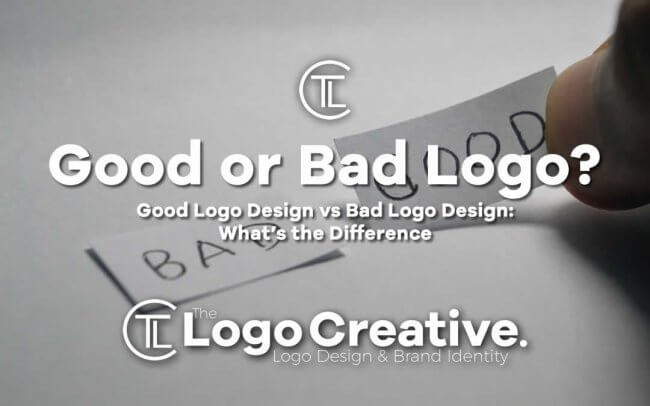A company without a logo is like a man without a face – no one can recognize it. It’s one of the most important elements of a brand’s visual identity and you need to approach logo design with all due attention and creativity. In this article, we talk about Good Logo Design vs Bad Logo Design: What’s the Difference.
The Internet is crowded with all sorts of agencies and individuals who promise attractive logo design, but it’s hard to choose the best one if you don’t know the traits and features of a beautiful logo. Graphic designers can make a lot of mistakes in the process, so you must prepare well and learn how to recognize quality visuals.
Our job is to help you with that, so keep reading to learn the differences between good and bad logo design. Let’s take a look!
Table of Contents
7 Differences between High and Low-Quality Logos
If you really want a perfect logo for your business, you should learn why this visual element is important in the first place. This is exactly why we prepared a list of logo design benefits:
- Brand recognition: A great logo helps your company to stand out from the crowd of competitors. A consumer takes eight impressions to memorize a logo design, but it can go much faster if you create an impressive visual.
- Reveal brand personality: Consumers should figure out the nature of your brand as soon as they see it.
- Professional authority: A well-designed logo proves that your business is highly professional.
- Visual consistency: Using logos across all communication platforms, you can achieve the highest level of visual consistency.
- Brand loyalty: Think about the McDonald’s logo for a while and you’ll realize how widely accepted it is among consumers worldwide. As your business keeps growing, your logo is going to become more popular among target audiences, which gives customers the notion of familiarity and boosts brand loyalty.
Now that you know what makes logos so powerful, it is time to delve deeper into the peculiarities of good and bad brand visuals. Here they are:
-
Professional VS amateur design
The first way to distinguish between low and high-quality logos is to analyze the nature of the design. It is fairly easy to recognize a logo created by a professional graphic design agency, but it’s even easier to notice amateur products created by beginner-level designers.
You can compare it with students searching for essay writing service UK: they can either choose the best essay writing service or stick to cheap but low-quality agencies. The same goes for logo design, but studies show that only 18% of businesses would actually pay for professional logo design. If you don’t want to risk professional credibility, you better pay the price of having a wonderful logo.
-
Niche-oriented VS generic design
The best logos are niche-oriented and they reveal the purpose of the business rather simply. The goal is not to make a super-detailed logo, but you do want to create a product which clearly shows what you are doing.
On the other hand, the market is filled with generic logos that don’t really say much about the companies they are representing. Take a look at some logo template. Does it say anything to you? Can you guess what it represents?
We bet you can’t because it’s just way too generic. It doesn’t have any concrete meaning, which is exactly what you need to avoid. We highly recommend you speak to us here at The Logo Creative for a professional logo design service
-
Authentic VS stock files
Brands with authentic logos can really separate themselves from their biggest rivals and attract more customers with the sheer power of visual beauty. Jake Gardner, a graphic designer, says the best logos are unique by definition: “You don’t want to be like everybody else, so your logo must not seem too familiar.”
On the negative side of the logo spectrum, you will often find boring stock emblems and creations that lack authenticity. You should avoid such solutions or at least try to redesign stock logos to make them more compelling.
-
Timeless VS trendy logos
Another distinction between good and bad logo design is that quality emblems are timeless, while their less effective counterparts are trendy. Why is it so important for your business? The answer is simple – companies with evergreen logos can spend decades without making major changes to their visuals.
This is the opposite of trendy logos because they tend to be popular for one or two years the most and then fade into oblivion. In other words, you will have to change it frequently in order to stay relevant and interesting.
-
Simple VS complex design
Another thing you have to pay attention to is simplicity because simple logos are easy to remember and thus more impactful. Do you know the Nike logo? Of course, you do, everybody knows it. The Swoosh is extremely simple, but still, it’s the world’s most valuable logo.
The alternative is to create a complex logo, but most of these attempts eventually fail. You don’t want a logo that is too complicated and difficult to interpret because the audience won’t bother analyzing it.
-
Readable VS intricate wording
A lot of logos contain a short line of text and it serves a very specific purpose – to keep the viewers even more informed. But just like any other element, wording can also make logos good or bad. A good logo is clear and highly readable. It doesn’t have too many words and customers can figure it out almost instantly.
On the other side, bad logos contain too much wording. Such emblems look ugly and confusing, particularly when they contain strange or unusual fonts.
-
Design for clients VS design for yourself
If you are making a logo for someone else, the basic idea is to understand the needs and expectations of your client. Even the most attractive solution can go terribly wrong if it doesn’t align with the business needs of your customer. In other words, good logos are designed with your clients’ wishes in mind, while bad logos – however beautiful – fulfill the expectations of a designer only.
Conclusion
Logo design may seem like a routine job, but it’s actually a delicate process that can make or break the overall appearance of your brand. This is why you need to avoid common logo creation mistakes and find a way to make it unique and effective.
In this article, we explained to you the differences between good and bad logo design. Can you assess your own logo after reading our post? Have you made any blunders while creating it? Make sure to check it – you might find a good way to improve!
 Author Bio
Author Bio
Lauren Adley is a writer and the editor at UK Best Essays. She is dedicated to her family, work and friends. She is a keen guitar player also enjoys reading, and traveling. She is interested in educational, marketing and blogging.

